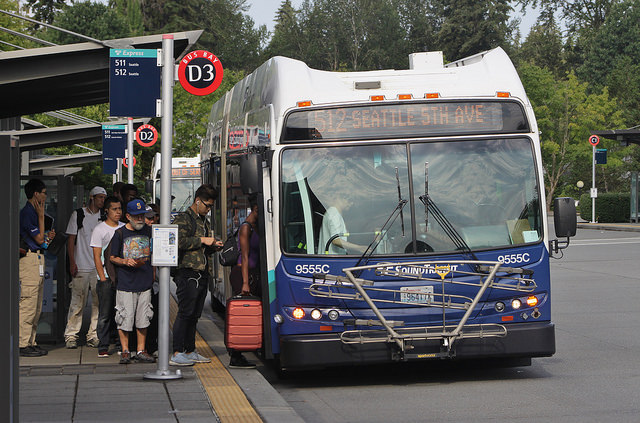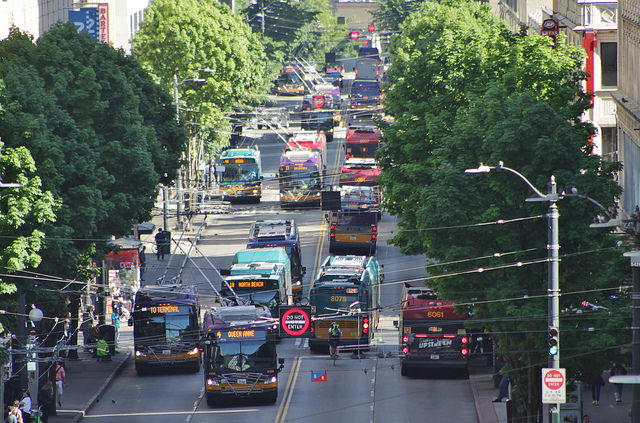As a community, Seattle has been struggling with numerous issues like income equality, our world-class congestion, and the regressive nature of our tax system. One way to effectively deal with these issues is by implementing a fare-free transit system.
A fare-free system can quickly and significantly allow low-income people to have more disposable income, reduce traffic congestion by getting more commuters on buses, and reduce the regressive nature of our high sales taxes.
Having an effective public transit system is directly correlated to an improved quality of life in our region. The community can more effectively be promoted when mobility restrictions are loosened, especially for transit-dependent populations including the elderly and low-income households. Additionally, fare collection and enforcement that currently costs millions of dollars would disappear along with the slowdowns and confusion that is inevitably caused by fare collection. Transit would be faster thanks to faster boarding, encouraging yet more ridership, and free transit would encourage tourists to ride transit rather than use services like Uber and Lyft that feed congestion.
The current subsidy level of our region’s transit agencies is already 70% to 80%, mostly coming from a sales tax, which again has a regressive incidence since low-income folks spend a larger share of their money, while the wealthy tend to save and invest. In King County, 23% of sales tax revenue is earmarked for King County Metro and Sound Transit operations and capital projects. Adding a simple payroll tax is a progressive and practical alternative to fund Metro and Sound Transit operations.
A small payroll tax, designed to a large extent like the Social Security and Medicare taxes that we already pay, could fund all Metro and Sound Transit operating costs, and, like them, are shared by employer and employee (the first $30,000 of employee income would be exempt from the tax to protect low income households). The tax revenues would be explicitly earmarked to Metro and Sound Transit operations and the maximum tax rate fixed so that it could not be raised above a certain level without a vote of the people.
In 2019, a 1% payroll tax on employers and employees in King County would generate $2.15 billion dollars (based on expected King County payroll using U.S. Bureau of Labor Statistics data). If Snohomish and Pierce County payroll were added, the number increases further–those two counties have employment of nearly 600,000 while King County’s employment is almost 1.4 million. Combined Metro and Sound Transit operating costs for 2019 are $1.26 billion, so even with a 30% increase in service, which would be necessary to accommodate a certain increase in ridership, the funding is more than covered.

To stay current, the $30,000 tax exemption could be indexed to the Consumer Price Index. A payroll tax like this would increase as county employment and average wages increase and would be much more stable than relying on sales tax receipts, which are prone to crater during recessions. Metro funding from sales tax decreased 12.94% during 2008-2009 while county payroll during the same time period only decreased 3.3%. This is crucial because transit demand tends to increase during recessions as people try to lower their transportation costs to make ends meet, but transit agencies are often forced to cut to make their budgets balance.
When the transit system is already heavily subsidized, transitioning to a fare-free system is not as drastic of a change as people might think. It is worth noting that farebox revenue in 2017, not accounting for the many costs associated with collecting and enforcing the fares, totaled $161 million for Metro and $90 million for Sound Transit.
The idea of abolishing fares is often criticized for making a negative impact on the financial stability of public transit networks, as it reduces farebox revenue to zero while increasing costs associated with higher passenger demand. But if we decreased the Metro and Sound Transit portion of sales tax by 65%, leaving the remaining portion for capital projects, while adding the 1% payroll tax, someone earning $100,000 per year would pay just over $3.00 per week, less than the cost of a latte.
If it seems utopian, it isn’t. There are two transit agencies in Washington with no fares, approximately 27 in the United States and almost 100 in other countries. Luxembourg, with a population of 600,000 will be the first country in the world to be completely fare free beginning in 2019. Even Paris, a city of 2.2 million, is currently undergoing a feasibility study to eliminate all fares.
It is important to distinguish the difference between eliminating fares to incentivize public transportation use with eliminating fares and increasing service. It has been demonstrated in transit departments all over the world that people will not ditch their cars if public transportation takes almost twice as long as driving, no matter the costs of the public transportation. This proposal is unique in that it provides the funding necessary to do both.
Increasing service and eliminating fares would benefit four specific stakeholders:
- Taxpayers who want faster commutes, cleaner air, and a more equitable tax system;
- Transit agencies striving for operational efficiencies and increased ridership;
- Current transit riders who depend on frequent and on time service to get to work; and
- Solo commuters who currently don’t have enough incentive to leave their cars at home.
Overcrowding may occur if ridership increases quicker than our ability to bring on additional service. It takes time to hire new drivers and purchase new buses, not to mention a place to park the bus when they’re not in use. But with some planning and a little time, an equilibrium could be found so current riders aren’t pushed away. These cost increases are expected and are more than covered with the payroll tax.
King County Metro has seen more growth in the past year than any large transit agency in the country, and it should be applauded. We have also seen incredible population growth in the region that is only worsening gridlock.
Multiple transportation groups are pushing for equitable solutions to get more people out of cars. Many positive steps have been taken that are showing promise but the problem will persist until a fundamental change in the way transit is funded is introduced.
This proposal will not be absent challenges; for the most part, preparing for a large increase in ridership and getting the full commitment of the organizations involved. But it is clear to us the benefits far outweigh the costs. Transportation is a basic function of a city because everybody benefits if everybody can easily make their optimum number of trips between home, work, shopping, events, medical appointments, and visiting family and friends.
Fare-free transit is something we should carefully consider. It is affordable and would have huge benefits for the region, not the least would be an immediate and tangible benefit to low-income families who have trouble making end’s meet.
The featured image is by Bruce Englehardt.
David Gordon received a degree in policy studies from the University of Washington, Bothell. He now works as a policy analyst focusing on transportation issues. He drives, takes the Sounder, and the Link, every morning, to get to his office in Seattle.

